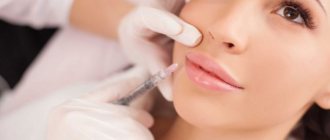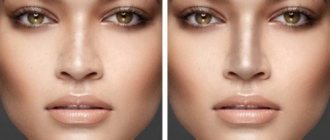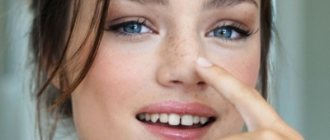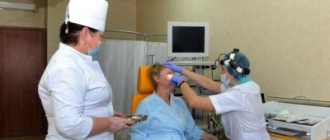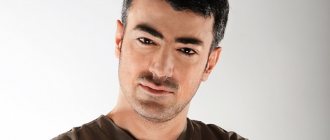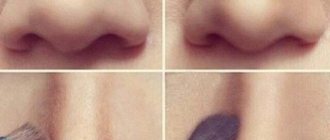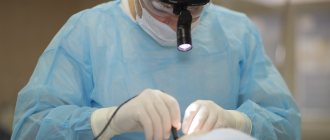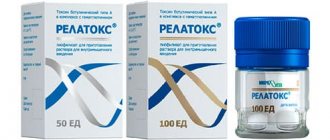Consultation with plastic surgeons with over 20 years of experience is free! Make an appointment by phone. Waiting for you! Non-surgical rhinoplasty is a minimally invasive method of nose correction using fillers and threads. The procedure is suitable for those patients who have minor nasal defects or are simply not yet ready for major surgery.
The non-surgical correction technique has both advantages and disadvantages that you should know about before deciding to undergo non-surgical rhinoplasty.
Indications and contraindications: medical, aesthetic, indirect, absolute
Rhinoplasty is a surgical operation that lasts 1–2 hours. As a result, the patient's appearance changes and the face becomes more attractive. Before undergoing plastic surgery, you need to agree on all the points with your doctor and thoroughly prepare for it: take tests, follow a diet, give up cigarettes and alcohol at least a week before the operation.
Indications for surgery
Indications for the procedure are congenital and acquired.
Congenital indications for plastic surgery include a variety of aesthetic and physiological defects: a hook-shaped, forked, thick or hanging tip, its displacement to the side, too wide or narrow nostrils.
Surgery may be necessary after injuries or diseases in which the nose is bent, as well as in case of difficulty breathing due to the structure of the organ or changes associated with age (aging of the skin). The above indications are considered acquired.
To restore or correct the tip of the nose, you need to consult a surgeon; if surgical intervention is necessary, the density of cartilage, thickness of skin and tissue, length, width of the nose, and other factors will be taken into account. The patient’s wishes are always taken into account and implemented as much as possible, but the final decision is made together with the doctor, because excessive removal of cartilage can lead to deterioration of health.
Before the operation, you need to examine the nasal cartilage, and also make sure that the skin in the area of the respiratory organ is healthy - there are no inflammations or signs of infection.
Contraindications for surgery
Correction of the tip of the nose is a serious procedure and must be approached consciously. What are the contraindications to the procedure?
- Age. The operation is performed from the age of 18. By this age, tissue formation is complete. However, surgeons recommend correction of the tip of the nose between the ages of 20 and 35 years. It is then that the formation of bones and cartilage is completed, the skin is elastic, and regeneration after the procedure occurs actively.
- Problems with blood clotting. When a patient has poor blood clotting, the risk of surgery is higher than usual and therefore it is better to refuse it.
- Exacerbation of chronic diseases. Surgeons do not recommend performing surgery during exacerbation of diseases. It is better to wait until your health condition returns to normal and undergo an examination. Only in case of positive test results can you decide to undergo rhinoplasty.
- Viral diseases, infections, inflammations. It must be remembered that if there are at least minimal health problems, it is better to postpone surgical intervention until complete recovery.
- Oncology. Rhinoplasty is contraindicated for patients with cancer.
- Menstruation. During menstruation, surgery is contraindicated. It is advisable to make the correction within two weeks after the end of menstruation.
It is also contraindicated to undergo plastic surgery during pregnancy or breastfeeding. Before the operation, the patient must undergo an examination and tests in order to ensure the necessary preparation for rhinoplasty.
How do lipolytics work?
The product is a biologically active material that is aimed at burning subcutaneous fat. During the chemical breakdown of fat, acids are formed, which are removed from the body naturally. Lipolitics have an additional lifting effect, making the skin soft and smooth. It is recommended to use this product in the presence of uncontrolled fat deposits on the body.
Note! Lipolitics are not a magic drug that will turn a fat person into a thin one. This remedy can provoke only minor weight loss. To get the full result, you need to add nutrition and exercise, or resort to liposuction.
Main types of lipolytics.
- Direct . These drugs have the most powerful effect, due to which they destroy not only the fat cell itself, but also its membrane.
- Indirect . A more gentle product based on herbal ingredients. Some of the most popular are caffeine or artichoke extract. This type of lipolytic is not capable of leading to dramatic changes, but will significantly improve the condition of the skin.
To fully consolidate the result after injections, additional drugs are used that promote the excretion of fatty acids. However, it is recommended to use these remedies only if it is impossible to lose weight in other, more gentle ways.
Other correction methods. Why rhinoplasty is the most reliable method
To correct the nose, surgeons use different surgical techniques depending on the wishes of the client and the result that the patient expects to receive. However, you can find other methods for correcting the tip of the nose on the Internet.
Clamps
In online stores you can find so-called “nose correction clips”. Manufacturers assure that when wearing correctors 2-3 times a day, an effect will be noticeable, comparable to surgical intervention. But, naturally, this is far from the truth. No clamps or other devices from pseudo-specialists are suitable for nose correction. If there is any effect, it will be short-term - for 2-3 weeks, and the correction is insignificant.
Exercises
There is a set of exercises for the face that allows you to adjust its shape. These exercises are useful for maintaining muscle tone, correcting cheekbones and double chin, but they will not correct the shape of cartilage. The effect after systematic exercise lasts for 2 weeks.
Correction with threads
The thread technique is carried out by a specialist with a special needle through micropunctures. Specially designed threads with notches are inserted into the skin of the nose to form a frame. The threads are inserted through small punctures, and the frame keeps it in the desired position. After two days, the doctor removes the ends of the threads and the patient sees the final result, which lasts about 3 years.
Use of hormonal drugs
To correct the tip of the nose, you can also take a course of hormonal medications. First of all, you need to consult an endocrinologist. If there are no contraindications, a hormonal drug can be administered. This procedure is performed to remove excess soft tissue and elevate the tip. For correction, you need to undergo a course of procedures that will last from 2 to 3 weeks. It is worth noting that the drugs provide a temporary effect - from 3 months to 2 years, depending on the drug chosen.
Surgical correction
According to experts, rhinoplasty is the most reliable and effective method of correction. Unlike previous methods, rhinoplasty provides lifelong results. Plastic surgery lasts 1–2 hours under local anesthesia or general anesthesia. Main advantages of the operation:
- all possible correction options (lower or raise the tip, reduce, straighten or narrow the tip of the nose);
- eliminating breathing problems;
- lifelong outcome;
- correction of injuries and birth defects.
What are lipolytics
Lipolitics are drugs whose action is aimed at burning subcutaneous fat, turning it into acids. The product is used to remove layers of fat, which helps reduce tissue volume. Lipolitics are used for the face, in particular the nose, mainly due to their safe action, because they are made from natural ingredients. According to customer reviews, the body responds well to the action of the drug. These drugs belong to mesoinjections; they are injected into the desired place using special thin needles, which reduce trauma to zero. Today, there are two main types of lipolytics, the difference between which is the method of action on the tissue.
A few words about the important things. Preparing for surgery
Before undergoing rhinoplasty, you need to undergo preparation. You will need to consult a plastic surgeon to discuss the desired changes. The surgeon examines the nose and explains the reality of obtaining the desired result. During the consultation, questions about limitations, the operation, features of its preparation, rehabilitation after it, as well as possible complications are discussed.
Before the operation, the patient needs to be examined to ensure that there are no contraindications and undergo the following tests:
- blood for HIV infection and hepatitis C and B;
- clinical blood test;
- blood biochemistry;
- laboratory urine analysis;
- prothrombin index analysis;
- fluorography;
- electrocardiography;
- tumor marker test;
- radiograph.
The patient also needs to listen to the doctor’s recommendations and adhere to them. Avoid drinking alcohol for a week before surgery, stop smoking, do not take blood thinners, and do not drink water or eat food for five hours before the procedure. It is important to refrain from active pastime and walking under the scorching sun a couple of days before rhinoplasty.
Cost of the procedure
Reducing the nose with lipolytics (reviews from girls point out the unique opportunity to use drugs to tighten the shape of the nose and cope with wrinkles that spoil the face, disappearing after the session) is a rather expensive procedure, the cost of which directly depends on the salon and the drug used for injection.
| A drug | Price |
| Super V-Line Sol, Lipo Lab V-Line, PBSerum. | from 9000 rub. |
| Dermaheal LL | from 15,000 rub. |
| Aqualyx | from 6000 rub. |
| LIGHTFIT | from 5000 rub. |
| MESOEYE C71 | from 10,000 rub. |
The price of the course will cost approximately 50 thousand rubles.
Additionally, a nose lift with threads may be required, which costs from 10,000 rubles.
In modern cosmetology, lipolytics, although considered an innovative technique, have already proven themselves quite well in the beauty industry. Unfortunately, such drugs can only slightly correct the shape of the nose, but only rhinoplasty can completely correct the respiratory system.
About the progress of the operation and its main stages
The first stage of the operation is anesthesia.
Rhinoplasty is performed under general or local anesthesia. The choice of type of anesthesia depends both on the wishes of the client and the specifics of the operation, and on the method that the plastic surgeon will use when performing it. The patient can always share his wishes regarding anesthesia, but the final decision is made by the doctor. The process and quality of rehabilitation after rhinoplasty also depends on the choice of type of anesthesia.
Local anesthesia is used for minor nose corrections using hormonal injections, fillers or threads. These correction methods do not cause severe pain, so general anesthesia is not required in most cases. But this type of anesthesia is practically not used during rhinoplasty, when the surgeon needs to touch the bones of the nose or eyes.
General anesthesia is used by the surgeon in most cases. This type of anesthesia allows you to completely avoid pain during the operation and the patient will not have any memories of the operation.
The operation lasts 1–2 hours. After anesthesia, the surgeon makes an incision in the skin or mucous membrane. Depending on the wishes of the patient and the specific case, the doctor selects an open or closed method for performing the operation.
During rhinoplasty, the doctor separates the soft tissue of the nose from the bone and cartilage tissue in the nasal cavity. Then he moves the cartilage and bone fragments and models a new shape of the nose. After the manipulations, the plastic surgeon applies absorbable sutures to the skin or mucous membrane, depending on where the incision was made. The next stage is packing the nasal passages with large gauze swabs. The final stage of the operation is the application of a fixing plaster bandage.
The type of incision is selected by the surgeon depending on the structure of the nose, the complexity of the procedure and the surgeon’s preferences in the work. The incision can be axial, perpendicular, oval or made at an angle.
Rhinoplasty itself is performed by three main methods: open, closed and combined. The features of each method are described in the “types of operation” paragraph.
The choice of plastic surgery method is presented to the patient directly, but doctors recommend choosing methods with the lowest level of injury. Surgeons claim that the least traumatic methods are closed and combined, since when they are used the incision is small and recovery after surgery is faster.
Reducing the nose with lipolytics reviews
Albina, 30 years old I read a lot about lipolytics, about their miraculous effect. I suffer from excess weight, which is especially noticeable in my face, which always seems to be swollen. Big cheeks and a fleshy nose. It seemed to me that it was impossible to reduce my nose without surgery. It was a little scary to go under the needles, but beauty is more important. I went for a consultation with a doctor, where he explained to me what effect I could ideally expect. The procedure went quickly, there was practically no pain, only the face was scary. They selected the drug RevitalCelluform for me. There was no rehabilitation. Of course, I expected more, but after a week, my face actually became smaller, my nose seemed to have deflated. I don’t know how long the effect will last, I’ll watch. The skin became like a baby’s, smooth and has a healthy, fresh appearance.
Surgeon's recommendations in the postoperative period. How to prevent complications
Rehabilitation after surgery averages 20 to 25 days. If rhinoplasty was performed under general anesthesia, the patient must also remain in the hospital for 24 hours after surgery.
For three days after surgery, gauze or cotton swabs should be placed in the nasal cavity to ensure immobility of the new forms and to prevent swelling. On days 5–8 (depending on the speed of healing), the suture material is removed after plastic surgery. After a week or 10 days, the patient’s plaster cast is removed, the hematomas and swelling begin to gradually subside.
Doctor's recommendations during the postoperative period:
- Sleep on your back and be sure to use a high pillow.
- To reduce the level of discomfort associated with dry mouth (as one of the possible consequences of the procedure), use special softening solutions or pastes.
- Do not abuse alcohol and smoking.
- Avoid going to baths, solariums, and saunas.
- Don't wear glasses.
- It is forbidden to overload yourself with physical activity.
- Temporarily avoid hot food and drinks.
- Do not touch, knead or feel your nose.
Possible complications
Complications after rhinoplasty occur in rare cases. Some of them appear immediately after correction, while others occur in later stages of healing. Natural complications include swelling and hematomas. External signs of swelling disappear within a week after plastic surgery, deep swelling disappears after six months. Difficulty breathing disappears on its own 10 days after surgery.
In order to protect yourself as much as possible from possible complications, it is important to carefully select a specialist, clinic and provide complete information about your state of health, injuries or diseases, if any. The final result of the operation also depends on strict adherence to the doctor’s recommendations during the rehabilitation period.
Side effects
Possible side effects of the procedure:
| Action | Effect |
| In case of incorrect selection of the drug formula. |
|
| When a lipolytic is injected into the muscle, and not into the subcutaneous fat. |
|
| Due to non-compliance with sanitary standards and violation of the rules of the rehabilitation period. | The appearance of a feverish state. |
The most common complications after the procedure are bruises, hematomas and a temporary increase in body temperature, which disappear on their own on the 7-14th day from the moment of drug administration. Nausea and dizziness occur much less frequently and can be caused by the patient’s individual intolerance to any drug.
If severe, painful complications occur, medical intervention is necessary.
Duration of effect and advice from cosmetologists
Reviews of girls who have undergone nose reduction with the help of lipolytics note that the first effect of the procedure becomes noticeable after the first 3 sessions and, with the right lifestyle, can last for quite a long time.
Reducing the nose with lipolytics. Photos before and after
For patients who have undergone lipolysis, cosmetologists advise:
- lead an active lifestyle, invariably accompanied by a lot of physical exercise;
- eat right, including in your diet a large variety of vegetables and fruits that help improve the health of the body and maintain weight at the required level;
- get rid of bad habits, and also minimize the consumption of sugary carbonated drinks and alcohol.
Proper facial care is also of particular importance, requiring the mandatory use of cosmetics with hyaluronic acid, which helps prolong youth and good skin condition.
To consolidate the result, cosmetologists recommend repeating a course of injections after 7-8 months. Reducing the nose with lipolytics is a modern, fairly common technique that allows you to cope with minor defects of the respiratory organ without the use of traumatic rhinoplasty tissue.
Having a small list of contraindications and, according to reviews, maintaining the effect for quite a long time, the procedure will help to cope not only with the voluminous wings of the nose filled with subcutaneous fat, but also tighten the skin, removing creases that appear with aging or tissue injury.


